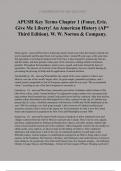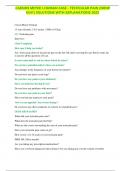©THEBRIGHTSTARS 2024/2025
APUSH Key Terms Chapter 1 (Foner, Eric.
Give Me Liberty! An American History (AP*
Third Edition). W. W. Norton & Company.
Maize (pg.8) - answer✔The Native Americans faced a food crisis when the climate warmed; the
wooly mammoth and the giant bison were going extinct. Around 9k years ago, at the same time
that agriculture was being developed in the Near East, it also emerged in modern-day Mexico
and the Andes, and then spread to other parts of the Americas, making settled civilizations
possible. Throughout the hemisphere, maize (corn), squash, and beans formed the basis of
agriculture. The absence of livestock in the Western Hemisphere, however, limited farming by
preventing the plowing of fields and the application of natural fertilizer.
Tenochtitlán (p. 10) - answer✔Tenochtitlán, the capital of the Aztec empire in what is now
Mexico, was one of the world's largest cities. Its great temple, splendid royal palace, and a
central market comparable to that of European capitals made the city seem "like an enchanted
vision," according to one of the first Europeans to encounter it.
Cahokia (p. 11) - answer✔More than a thousand years before Columbus sailed, Indians of the
Ohio River valley, called "mound builders" by eighteenth-century settlers who encountered the
large earthen burial mounds they created, had traded across half the continent. After their decline,
another culture flourished in the Mississippi River valley, centered on the city of Cahokia near
present day St. Louis, a fortified community with between 10,000 and 30,000 inhabitants in the
year 1200. Its residents, too, built giant mounds. Little is known of Cahokia's political and
economic structure. But it stood as the largest set- tled community in what is now the United
States until surpassed in population by New York and Philadelphia around 1800.
Iroquois (p. 12) - answer✔In eastern North America, hundreds of tribes inhabited towns and
villages scattered from the Gulf of Mexico to present-day Canada. They lived on corn, squash,
and beans, supplemented by fishing and hunting deer, turkeys, and other animals. Indian trade
routes crisscrossed the eastern part of the continent. Tribes frequently warred with one another to
obtain goods, seize captives, or take revenge for the killing of relatives. They conducted
diplomacy and made peace. Little in the way of centralized authority existed until, in the
fifteenth century, various leagues or confederations emerged in an effort to bring order to local
regions. In the Southeast, the Choctaw, Cherokee, and Chickasaw each united dozens of towns in
loose alliances. In present-day New York and Pennsylvania, five Iroquois peoples—the Mohawk,
Oneida, Cayuga, Seneca, and Onondaga—formed a Great League of Peace, bringing a period of
, ©THEBRIGHTSTARS 2024/2025
stability to the area. Each year a Great Council, with representatives from the five groupings, met
to coordinate behavior toward outsiders
"Christian liberty" (p. 18) - answer✔One conception common throughout Europe understood
freedom less as a political or social status than as a moral or spiritual condition. Freedom meant
abandoning the life of sin to embrace the teachings of Christ. In this definition, servitude and
freedom were mutually reinforcing, not contradictory states, since those who accepted the
teachings of Christ simultaneously became "free from sin" and "servants to God." "Christian
liberty" had no connection to later ideas of religious toleration, a notion that scarcely existed
anywhere on the eve of colonization
Zheng He (p. 20) - answer✔At the beginning of the fifteenth century, one might have predicted
that China would establish the world's first global empire. Between 1405 and 1433, Admiral
Zheng He led seven large naval expeditions in the Indian Ocean. On his sixth voyage, Zheng
explored the coast of East Africa. China was already the world's most important trading
economy, with trade routes dotting the Indian Ocean. Zheng's purpose was not discovery, but to
impress other peoples with China's might. Had his ships continued west-ward, they could easily
have reached North and South America. But as a wealthy land-based empire, China did not feel
the need for overseas expansion, and after 1433 the government ended support for long-distance
maritime expeditions. It fell to Portugal, situated on the western corner of the Iberian Peninsula,
far removed from the overland route to Asia, to take advantage of new techniques of sailing and
navigation to begin exploring the Atlantic.
Caravel (p. 20) - answer✔The development of the caravel, a ship capable of long-distance travel,
and of the compass and quadrant, devices that enabled sailors to determine their location and
direction with greater accuracy than in the past, made it possible to sail down the coast of Africa
and return to Portugal.
Factories (p.22) - answer✔In 1485, the Portuguese reached Benin, an imposing city whose
craftsmen produced bronze sculptures that still inspire admiration for their artistic beauty and
superb casting techniques. The Portuguese established fortified trading posts on the western coast
of Africa. The profits reaped by these Portuguese "factories"—so named because merchants were
known as "factors"—inspired other European powers to follow in their footsteps.
Reconquista (p. 23) - answer✔Columbus sought financial support throughout Europe for the
planned voyage. Most of Columbus's contemporaries, however, knew that he considerably
underestimated the earth's size, which helps to explain why he had trouble gaining backers for
his expedition. Eventually, King Ferdinand and Queen Isabella of Spain agreed to become
sponsors. Their marriage in 1469 had united the warring kingdoms of Aragon and Castile. In
1492, they completed the reconquista—the "reconquest" of Spain from the Moors, African
Muslims who had occupied part of the Iberian Peninsula for cen- turies. The capture of Grenada,
the Moors' last stronghold, accomplished Spain's territorial unification. To ensure its religious
unification, Ferdinand and Isabella ordered all Muslims and Jews to convert to Catholicism or
leave the country. Along with the crown, much of Columbus's financing came from bankers and





